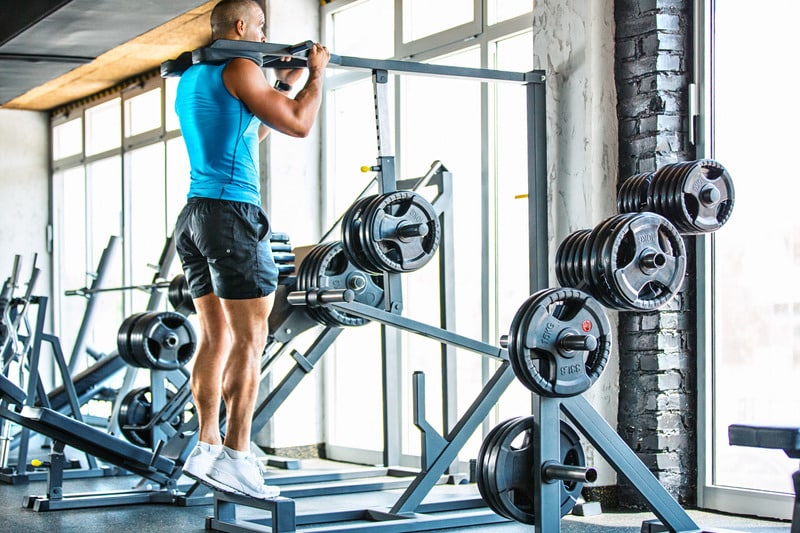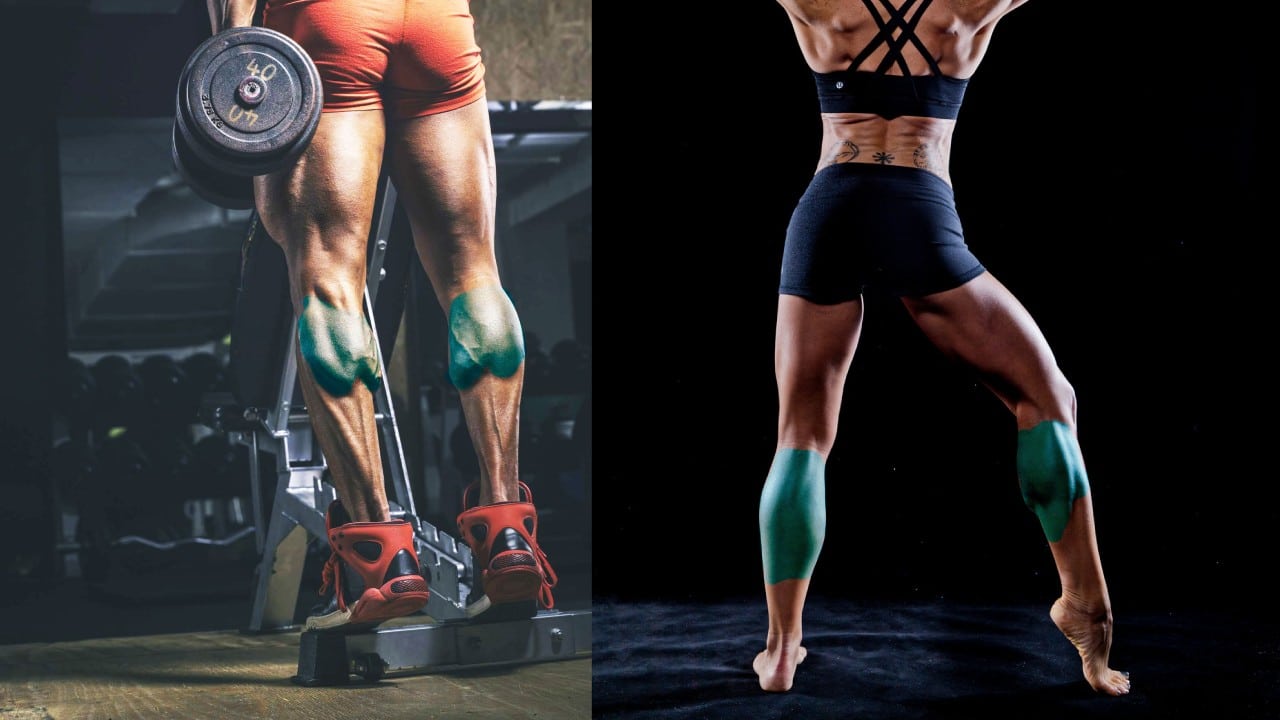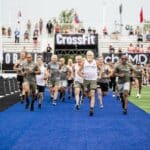Discover the average calf size for men and women and why it matters more than you think.
This article presents detailed norms based on CDC data, revealing how calf size is influenced by factors such as genetics, age, and lifestyle. Learn the significance of calf circumference in assessing muscle health, its connection to overall physical performance, and its role as an indicator of potential health risks like sarcopenia and obesity.
Let’s get to it.
Related: Discover the average forearm, bicep and chest size.
Jump to:
- Average Calf Size For Men And Women
- Factors Affecting Calf Size
- Calf Size Measurements
- Calf Size and Body Composition
- Health Implications of Calf Size
- Importance of Proportions in Physique
- Calf Training and Development
- Aesthetics and Appearance of Calves
- Tailoring Fitness Goals for Calf Enhancement
- Nutrition and Supplements for Optimal Calf Development
Average Calf Size For Men And Women
For men, average calf sizes typically range upwards from about 15.5 inches (39.5cm), but keep in mind that athletic individuals or those engaged in regular strength training may have larger calves due to muscle development.
For women, average calf sizes usually start around 15 inches (38.3 cm); again, this measurement can be higher for those with more muscular physiques.
According to the CDC (Centers for Disease Control and Prevention), here’s the maximal calf circumference, in centimeters, for females 20 years of age and older, by mean, standard error of the mean, and selected percentiles:
| Women | Number Examined | Mean | Standard Error | 5th | 10th | 15th | 25th | 50th | 75th | 85th | 90th | 95th |
| Average | 4,133 | 38.3 | 0.13 | 31.8 | 33 | 33.8 | 35 | 37.5 | 40.9 | 43 | 44.7 | 47.1 |
| 20–29 years | 676 | 37.8 | 0.25 | 31.5 | 32.4 | 33.1 | 34.5 | 37.1 | 40.2 | 41.9 | 43.7 | 46.6 |
| 30–39 years | 648 | 38.7 | 0.23 | 32.2 | 33.6 | 34.1 | 35.3 | 38 | 41.2 | 43.4 | 45.3 | 47.2 |
| 40–49 years | 765 | 39.2 | 0.27 | 32.8 | 33.8 | 34.6 | 35.7 | 38.5 | 42.1 | 44.2 | 45.6 | 47.8 |
| 50–59 years | 578 | 38.7 | 0.24 | 32.3 | 33.4 | 34.3 | 35.5 | 37.7 | 41.3 | 43.1 | 44.3 | 47.4 |
| 60–69 years | 673 | 38.5 | 0.3 | 31.5 | 32.6 | 33.6 | 35.2 | 37.6 | 41.1 | 43.1 | 44.6 | 47.2 |
| 70–79 years | 437 | 36.8 | 0.27 | 31.1 | 32.1 | 32.9 | 33.9 | 36.2 | 39 | 40.6 | 42 | 44.7 |
And here’s the data for males 20 years of age and older:
| Men | Number Examined | Mean | Standard Error | 5th | 10th | 15th | 25th | 50th | 75th | 85th | 90th | 95th |
| Average | 4,303 | 39.5 | 0.09 | 33.6 | 34.7 | 35.6 | 36.9 | 39.2 | 41.9 | 43.4 | 44.4 | 46.4 |
| 20–29 years | 779 | 39.4 | 0.19 | 33.5 | 34.7 | 35.4 | 36.7 | 38.7 | 41.3 | 43.4 | 45.1 | 47.3 |
| 30–39 years | 714 | 39.8 | 0.17 | 34.1 | 34.9 | 35.8 | 36.9 | 39.5 | 42.2 | 43.5 | 44.5 | 46.5 |
| 40–49 years | 748 | 40.3 | 0.16 | 34.7 | 35.9 | 36.5 | 37.8 | 40 | 42.7 | 44.2 | 44.9 | 46.7 |
| 50–59 years | 568 | 39.8 | 0.2 | 33.7 | 34.9 | 35.9 | 37.2 | 39.6 | 42 | 43.4 | 44.6 | 46 |
| 60–69 years | 648 | 39.2 | 0.18 | 33.4 | 34.5 | 35.7 | 36.9 | 39.1 | 41.7 | 42.8 | 43.6 | 44.8 |
| 70–79 years | 530 | 38 | 0.22 | 32.3 | 33.7 | 34.2 | 35.5 | 37.7 | 40.2 | 41.3 | 42.5 | 44.2 |
Your calf size is not just an aesthetic characteristic but is also related to your physical performance and can be an indicator of overall muscle health.
Measuring calf circumference can sometimes be used as a quick reference for muscle mass, particularly in the context of health and aging.
The relationship between calf circumference and muscle mass and mortality has been studied, providing insight into the importance of maintaining muscle mass for longevity.
Factors Affecting Calf Size
Your calf size is influenced by various factors including genetics, age, and your overall body composition. Understanding how each element plays a role can help you better appreciate the nuances of calf size.
Genetics and Calf Size
Your genetics determine the foundational structure of your body, including your calf muscles. Genetic predisposition greatly influences muscle mass and proportions, which can result in significant differences in calf size from one individual to another. For instance, certain genetic profiles may naturally lead to larger calves, even without additional weight training.
Age and Calf Proportions
As you age, changes in your body’s proportions can affect calf size. Generally, muscle mass tends to decrease with age, potentially leading to smaller calf muscles. However, with regular exercise focusing on calf-strengthening activities, it’s possible to maintain or even increase calf size regardless of age.
Impact of Weight and Fat on Calf Size
Your overall weight and body fat percentage also play crucial roles in determining your calf size. Excess fat can increase the size of your calves, while a higher muscle mass contributes to well-defined calves. Balancing your body composition through a combination of diet and exercise is key to optimizing calf size for your specific body type.
Calf Size Measurements

Accurate measurement of your calf size is crucial for various health assessments, such as determining muscle mass or diagnosing conditions like sarcopenia.
Tools for Measuring Calf Circumference
Tape Measure: A flexible, non-stretchable tape measure is the primary tool you should use for measuring calf circumference. It should be able to wrap comfortably around the widest part of your calf.
Skinfold Caliper: Although less common for calf measurement, a caliper can be used for more specific body composition analysis and requires calibration and appropriate training to ensure accurate measurements.
Guidelines on How to Measure Your Calf Size
Proper Positioning: To measure your calf size, stand upright with your feet shoulder-width apart. Your weight should be evenly distributed across both legs.
Measuring Procedure:
- Identify the widest part of your calf.
- Wrap the measuring tape around your calf, ensuring it remains parallel to the floor.
- Firmly, but not tightly, pull the tape measure so it sits snugly on the skin without causing an indentation.
- Record the measurement to the nearest 0.1 inch or centimeter.
Remember, consistency is key for tracking changes over time, so always measure your calf at the same point, using the same method.
Calf Size and Body Composition
Your calf size is not only an aesthetic feature but also a marker of your body’s muscle to fat ratio and lean body mass. It is influenced by both genetic and lifestyle factors, affecting overall body composition.
Analyzing Muscle to Fat Ratio
Your calves consist of a significant amount of muscle tissue, which can vary in size according to your muscle mass and the amount of body fat present. Since muscles are denser than fat, individuals with a higher percentage of muscle mass in their calves will typically have larger calf circumferences. For instance, studies have indicated that smaller arm and leg circumferences can reflect higher skinfold thickness, while larger circumferences indicate greater muscle bulk.
Understanding Calf Size in Context of Lean Body Mass
Lean body mass refers to the weight of your body minus all the weight due to your fat mass. This includes the weight of your muscles, bones, organs, and other non-fat tissues. An increase in the size of your calves may signify an increase in lean body mass, particularly if it is accompanied by physical training targeted at muscle growth. Conversely, a decrease in calf circumference may suggest a decrease in lean body mass, which could be a concern for conditions such as sarcopenia. Calibrating the measurements of your calf circumference can offer insights into your overall body composition and hint at changes in muscle mass and body fat levels.
Health Implications of Calf Size
The size of your calf muscles can indicate more than just strength; it’s interwoven with various health outcomes, including risks for sarcopenia and obesity.
Correlation Between Calf Size and Overall Health
Muscle strength is often mirrored by the circumference of your calves. Typically, a larger calf circumference indicates greater muscle mass and, by extension, suggests better overall health. There’s a relationship between the size of your calves and the health of your arteries. Well-developed calf muscles may encourage better blood flow and reduce the risk of vascular diseases.
Calf Size and Risk of Sarcopenia and Obesity
Your calf size can be a reliable indicator of sarcopenia, which is the loss of muscle tissue as a natural part of the aging process.
A smaller calf circumference is linked to a higher risk of sarcopenia. Adults with calf circumferences below the thresholds—less than 34 cm in men and less than 33 cm in women—may need evaluation for sarcopenia.
On the flip side, calves that are disproportionately large may suggest obesity, particularly if the large size is due to fat rather than muscle. Hence, maintaining an optimum calf size, indicative of a healthy muscle-to-fat ratio, is crucial for minimizing the risk of both sarcopenia and obesity.
Importance of Proportions in Physique
Your body’s proportions play a critical role in determining your overall physique. How each body part aligns and balances with the others can enhance both aesthetic appeal and functional performance.
Balance Between Calf Size and Other Body Parts
When examining body proportions, particular attention is given to the relationship between calf size and other body parts like the arms, chest, hips, and waist.
Harmonious proportions, where the calf size complements the size of your biceps and thighs, contribute to a balanced, symmetrical appearance. In contrast, disproportionate calf size can disrupt the aesthetic flow of your physique.
Symmetry is key in creating a physique that is not only visually appealing but also implies a well-rounded strength and fitness level. For instance, while a well-defined chest and arms might be your priority, ignoring your calf development can lead to a mismatch that might detract from your physique’s symmetry.
Here’s a simple way to assess your body’s symmetry:
- Measure the circumference of your calves, biceps, and thighs.
- Document these measurements in a table for easy comparison.
| Body Part | Ideal Circumference Ratio |
| Calves | 1:1 with biceps |
| Thighs | 1:1 with chest |
| Waist | Preferably less than hips |
Your goal should be to maintain proportionality—aesthetic standards often suggest that your calves should ideally match your arm circumference. However, remember that ideal ratios may vary based on body types, and an individual’s goals and genetics play a significant role in determining their natural body proportions.
Calf Training and Development
Developing well-defined calf muscles requires a combination of targeted exercises, proper nutrition, and sufficient recovery time. This section will guide you through each of these critical elements to ensure effective calf growth and strength enhancement.
Exercises for Building Calf Muscle

Your calf muscle group consists mainly of two muscles: the gastrocnemius and the soleus. To build these muscles, you’ll want to incorporate a variety of exercises into your routine.
- Standing Calf Raises: Focus on the gastrocnemius. Stand on the edge of a step and raise your heels, then lower them below the step level.
- Seated Calf Raises: Target the soleus. Sit with your knees at a 90-degree angle and lift your heels by pushing against resistance.
For the best results, aim for 3 sets of 12-15 reps for each exercise, twice a week, alongside your regular gym regimen.
Importance of Diet and Nutrition in Calf Development
Building muscle isn’t just about working out; what you consume is just as crucial. Your diet should include:
- Proteins: Lean meats, eggs, and legumes are excellent sources of the protein needed for muscle repair and growth.
- Carbohydrates: Whole grains and vegetables provide the energy required for intense training sessions.
Balance your diet with a mix of macronutrients and micro to fuel your workouts and aid in recovery.
Role of Recovery in Muscle Growth
Muscle development happens when you’re not working out—during recovery. To maximize gains:
- Allow for rest days to let your muscle groups heal and grow.
- Ensure you get adequate sleep; 7-9 hours is ideal for muscle recovery.
Remember, your muscles need downtime to respond to the stress of training and come back stronger.
Aesthetics and Appearance of Calves
Your calves may not be the first thing you think of when assessing physical attractiveness, but they play a significant role in balancing overall body aesthetics and contributing to your appearance. Specific cultural standards and personal preferences impact how calf size is perceived.
Cultural Perceptions of Calf Size
In various cultures, the size of your calves can be a mark of beauty or strength.
Big calves may be seen as a sign of robust health and athletic ability, sometimes relating to success in sports or physical endeavors. Meanwhile, opinions on what constitutes the ideal calf size can vary, with some cultures preferring more slender calves that align with different aesthetic standards. It’s important to recognize that cultural feedback can deeply influence personal satisfaction with one’s appearance.
Calf Size and Fashion Choices
Your calf size could influence your fashion choices and how clothes fit you, particularly when selecting pants or boots. For example:
- Boots: May be challenging to find if you have larger calves.
- Skinny Jeans: Can accentuate the size of your calves, whether big or small.
A balanced appearance is often the goal for many, and adapting fashion choices could be a strategy to achieve that balance, either by accentuating or downplaying the size of your calves. Consider these aspects when shopping for clothing to ensure both comfort and the desired representation of your body shape.
Tailoring Fitness Goals for Calf Enhancement
Achieving well-defined calves requires a tailored approach that aligns with your unique body composition and fitness level. Here, you’ll find guidance to set realistic goals and monitor your gains, ensuring that your dedication to calf enhancement is met with success.
Setting Realistic Expectations for Calf Size Improvement
Your calf size is influenced by genetics, but with the right training regimen, improvements are attainable. When you embark on this journey, it’s important to establish goals that reflect a balance between ambition and what’s realistically achievable for your body type. Start by measuring your body weight and calf circumference to create a baseline.
- Initial Assessment
- Measure calf circumference at the widest point.
- Record body weight for context.
Adopting a variety of exercises within your gym routine, from resistance training to balance and endurance work, will foster a conducive environment for muscle growth. Consider these key exercises to include in your training:
- Resistance Training: Calf raises, leg presses, and seated calf extensions.
- Balance and Bodyweight Exercises: Single-leg balances and plyometric jumps to engage stabilizer muscles.
- Endurance Activities: Incorporating cycling or running can offer comprehensive development.
Monitoring Progress and Adjusting Training Regimens
As with any fitness endeavor, feedback plays a crucial role in steering you toward your goals. It is essential to track your progress through regular measurement and, if available, photographic documentation. This not only serves for motivation but also helps you make data-driven adjustments to your regimen.
- Bi-weekly Checkpoints
- Measure calf size every two weeks.
- Note changes or plateaus in size and strength.
If you notice a stagnation in progress, it may be time to review and adjust your gym routine. A change could mean different exercises, increased resistance, or more focus on endurance. Your calf enhancement success will rely on periodic assessment and a willingness to adapt your training regimen to the feedback your body provides. Remember, the ideal feedback loop consists of setting goals, executing your plan, observing results, and making the necessary adjustments for continued growth.
Nutrition and Supplements for Optimal Calf Development
Proper nutrition plays a pivotal role in muscle development, and when it comes to enhancing the size and strength of your calves, incorporating the right balance of nutrients is essential. A protein-rich diet supports the repair and growth of muscle tissue, serving as the building block for your calves.
When planning your meals, aim for a variety of protein sources such as:
- Lean meats
- Dairy products
- Legumes
- Nuts and seeds
In addition to whole food sources, consider supplementing with whey or plant-based protein powders to meet your daily protein requirements.
Carbohydrates are also vital as they provide the energy needed for intense calf-training sessions. Opt for complex carbs like whole grains, which offer sustained energy release. For health and muscle function, incorporate a rainbow of fruits and vegetables to ensure you’re getting a broad spectrum of vitamins and minerals.
Nutritional supplements may also aid in calf development. These can include:
- Creatine, to support energy production and muscle endurance.
- Omega-3 fatty acids found in fish oil, which can aid in recovery and inflammation reduction.
- Vitamin D and calcium, which are crucial for bone health and muscular contraction.
Remember to stay hydrated; water is crucial for all bodily functions, including muscle performance and recovery.
Here’s a quick reference for your calf nutrition plan:
| Nutrient | Food Sources | Supplements |
| Protein | Lean meats, Dairy, Legumes | Whey, Plant-based powders |
| Carbohydrates | Whole grains, Fruits | – |
| Fats | Nuts, Seeds, Fish | Omega-3, Fish oil |
| Vitamins | Fruits, Vegetables | Multivitamins |
| Minerals | Leafy greens, Dairy | Calcium, Magnesium |
Tailor your intake to your body’s needs and consider consulting with a nutritionist to optimize your diet for muscle growth and overall well-being.














